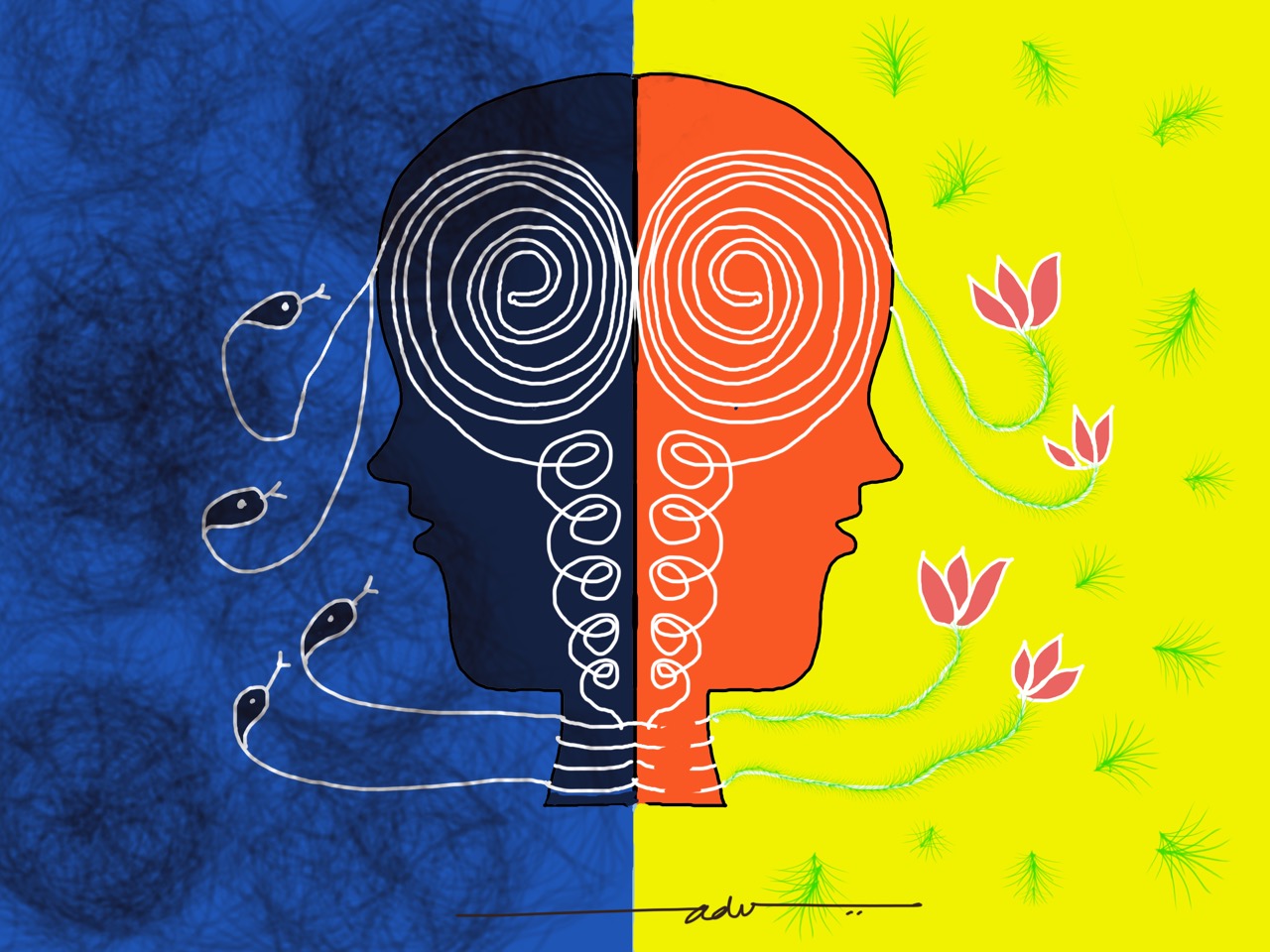
Living without hope, without anything to look forward to, without the zeal and enthusiasm for anything in life; – a good enough reason for someone to think why he should get up today and trudge it. What difference is it going to make anyways in the world that I try to belong to? Suicidal thoughts indeed!! Where do these seeds come from? Why do they breed to captivate the mind completely and make one take the drastic step? Sushant Singh Rajput’s suicide has stirred the whole country and fans beyond. If that dark moment was over; could he still be alive? Could we regulate the brain’s biochemistry to skip that move? More importantly, as a society how can we become more empathetic towards people struggling with depression? How can we gauge beyond their surface level smiles? How can we train our brains to be more compassionate and express love and care to those, who may need it the most?
Generally, depression is the underlying cause of suicide. Unlike many other mental health issues, depression was not considered even a health condition until when a few people boldly shared their stories about it. We cannot differentiate much between feeling low or sad and depression. Scientifically, sadness is a healthy emotion to respond to unhappy events in our lives. This emotion motivates us to make our lives happier. But depression on the other hand works the opposite. We can say how some sad movie or music can help a person emote and let out his negativity to move on. But for a depressed person, it may work like fuel to fire. It makes them stay there to loom more into the doom. Depression is not an emotion but a mental illness.
One of biggest reason associated with depression is isolation. Usually extroverts tend to be more vocal in sharing how they feel. But introverts which make up to 74% of the depressed population (Journal of Psychiatric Research) withdraw from others and keep their feelings to themselves. Choosing self-isolation for a little ‘me time’- that quiet time is good to relieve stress, or for some thinking and creativity. It is different from forced isolation. Solitude because of inability to get along with circumstances and other people drifts into demotivation and unproductivity; which in turn makes it all the more depressing. Selective introversion is apparently healthier.
General symptoms of depression are feeling sad and fatigued (almost always), being irritable, reckless, lack of focus, wanting to be left alone, just keep pondering over negativity, self-loathing, inability to find happiness or joys in anything. There is hopelessness, despair, void, losing meaning of life and the sadness starts interfering with the routine; Kind of making one sink in this black hole.
As per WHO, depression and suicide is a major concern of the 21st century and about 800,000 people die out of depression annually, especially impacting the youngsters. Surprisingly, while most women are diagnosed with depression and attempt to suicides; male suicide rate is much higher all over the world. Because males have better access and they are stronger with the intent to complete the act (BBC.com). Men tend to bottle up their feelings and do not want to share their vulnerability. There may be several factors such as unemployment, debts, relationship issues, illness, losing someone, teenage trauma or loneliness etc. to cause depression.
Some people are too depressed and continue to live with suicidal thoughts without having the energy to act on it- a nightmare for anyone, especially their family caregivers. But the other type could be just shocking which is widely being acknowledged as ‘smiling depression’. Here a person will show a happy face, react positively to appreciation or any good news. He would be successful on the exterior; but will be battling a storm inside. He is the most vulnerable one to end it all in no time! But symptoms of such people can be observed in their lethargy, isolation, oversleeping and being overly sensitive to any criticism.
While there are many psychological reasons associated with depression, a little is known about the neurobiology of it. Scientific reports show that usually suicidal brains have reduced activity of serotonin (a chemical that lifts mood). Also there is an irregular distribution of GABA (Gamma aminobutyric acid) – an important neurotransmitter to put brakes on a neuron activity. Something that can make a person STOP! A study suggests 300% higher levels of quinolinic acid (a compound generated due to inflammation) in the CNS of suicide attempters (Science Direct). It is similar to glutamate that excites nerve cells. Anti-glutamate may be considered as a medication (LiveScience.com). But our brain and mental illnesses are so complex that it is quite difficult to pin down just a few chemicals as there are millions of reactions happening inside of us to make us feel, what we feel.
Scientists attribute to genetic predisposition as well. The hippocampus of depressed women in a study was 9% to 13% smaller than the normal (The Journal of Neuroscience). Further, the neurons do not regenerate in prolonged stress conditions in this area. In another study artists are 25% more likely to carry the genes of mental illness. According to David Foster Wallace who himself committed suicide; mild depression can lead to creation of art through introspection, but deep depression can be addictive for a person to socially isolate himself (Psychology Today). Contrary to art therapies for depressed people; often creative geniuses are associated with madness. Artists are 4 times more likely to commit suicide. According to Dennis Pulambo (Screenwriter turned licensed psychotherapist), artists have more access to their feelings compared to people in other professions.
Feeling hollow inside is mostly associated with failures in life or being lonely. But very well to do and highly successful people with spouses and kids or being in romantic relationships do it too. Mostly due to the unlimited pressure of not tripping down from their position and rather keep pushing for more. Sometimes there is also probably the saturation of having it all, seen it all. There seems nothing more to seek- which is adverse to the basic nature of human mindset.
Mostly, there may not be a single cause for committing suicide, but multiple factors leading to it. One person dies every 40 seconds in the world (WHO) and it can be prevented. Sometimes it is just an impulsive move rather than a planned approach. Can we do something about saving people from themselves?
Usually if a person has low mood or sadness for over 2 weeks, they must talk about it with a therapist. Anti-depressants are also recommended. But a close monitoring by family caregivers is recommended as they come with side effects, such as increasing the symptoms as the course begins. Artists have also reported their minds being numb when they were on these medications. CBT (Cognitive Behavioral therapy) is effective in many cases especially people getting impacted with the environment, or the seasons, or handling grief.
Taking life too seriously is a risk of educated and intellectual people who are in the spot of becoming, being competitive proving to themselves and others. Uneducated, not so well to do people who live without fear of losing it, living the mundane have happier lives. Self-compassion is one of the keys to overcome constant self-bullying or being bullied by others or the society. Lifting oneself up with small steps at a time to overcome negative feelings is a process to come out of the darkness. Meditation, exercise they are all important. But most important is getting out there, talking to someone- sharing the feelings.
The biggest of all could be keeping busy distracting from self- actually moving with a bigger purpose. A purpose beyond SELF- to help someone; who may need care; who might be old, disabled, or lonely; who might be poor, hungry, weak, uneducated. Getting distracted from own self would help a lot to bounce back from those depressing feelings. By empowering someone else, one may feel more empowered and worthy within. Sushant Singh also had some amazing wishes to live on with a purpose of giving- to help women learn self-defense, to help the blind with assistive technologies, help kids learn about space- sending them to ISRO/NASA. Wish if he would have shared sooner with some like-minded and started on some of it already. It is such a loss of humanity where we lose people with such golden hearts and get awe-struck with those flashing gold!
In our thousands of connections, we must have at least a few good friends, some people to talk to and share. As a society we can create a positive atmosphere to be generally appreciative and being kind. Let’s not be too harsh in passing our judgements; else people will not reach out and talk. Making people comfortable in expressing their vulnerability and making them feel that they are ‘not alone’ could help them save.
Dr. Anju Dave Vaish
Founder, Creative Director
TRY for GOOD | CoffeebeanMedia
Dr. Anju is a Branding and Sustainability professional with special focus into Bio Science & Technology sector. A certified Happiness Coach from UC Berkley, USA, she also focuses into inner sustainability for individuals and corporates.
Published in the Biovoice
